Annual State of NHSScotland Assets and Facilities Report for 2013
A review of asset and facilities management performance in NHSScotland, identifying the current state of the estate and facilities management, highlighting areas of best practice and areas for improvement.
Annex B: Review of Estate Assets and Performance
This Annex provides a detailed analysis of property asset performance which supports the summarised information and analysis provided in the main body of the report. The information presented in this annex within the pie charts combines information from all 22 NHS Boards and Special NHS Boards, whereas the subsequent charts and tables split the analysis between the 16 Boards with in-patient accommodation (labelled NHS Boards), i.e. all 14 NHS Boards plus 2 Special NHS Boards (NHS National Waiting Times Centre - Golden Jubilee and the State Hospitals Board for Scotland), and the 6 remaining Special NHS Boards.
Estate Age
NHSScotland occupies approximately 900,000sq.m (20% of the total) of relatively new / modern accommodation (i.e. less than 10 years old), which is an increase of 210,000sq.m since 2011, and is evidence of the significant capital investment in property assets over recent years. There does, however, remain substantial scope for improvement and further investment, or disposal, in the estate in order to move away from old, poor quality and functionally unsuitable properties. The following charts show the range of property ages for the NHS Boards, which indicates that 28% of the estate remains over 50 years old.
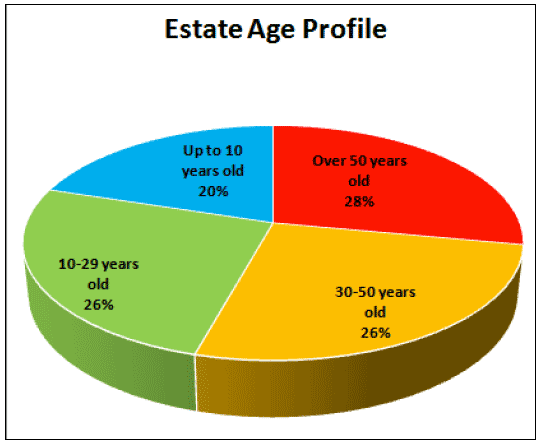
Age profile above includes all 22 NHS Boards and Special NHS Boards
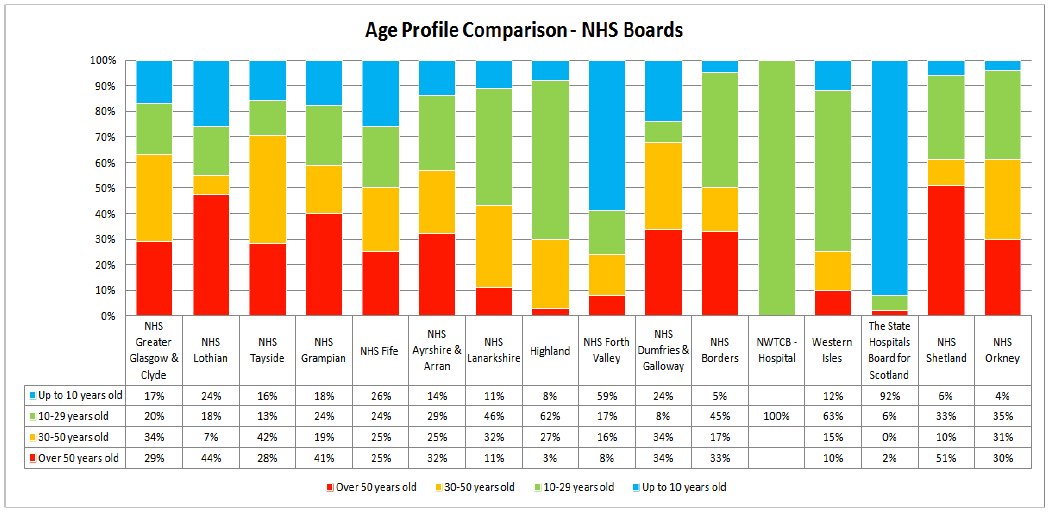
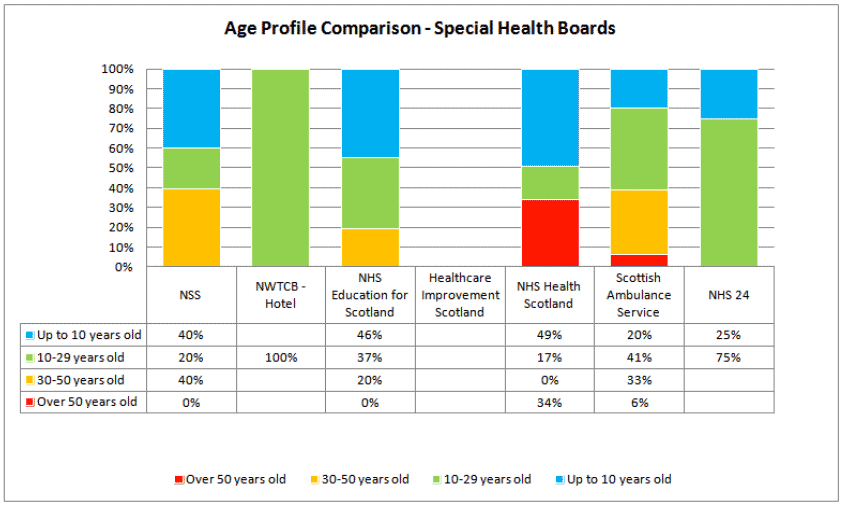
Estate Tenure
The majority of the NHSScotland estate is owned (78%) but for some NHS Boards PPP/PFI and leased property is a significant proportion of their estate, as shown in the two charts that follow.
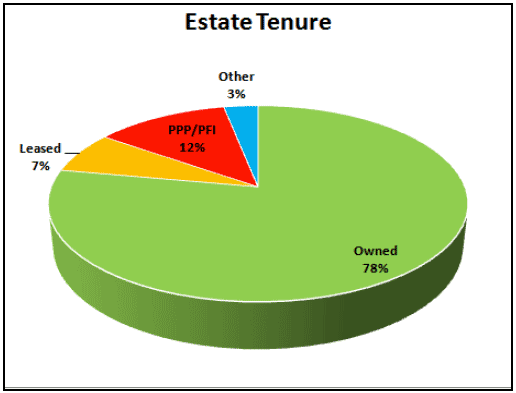
Tenure profile above includes all 22 NHS Boards and Special NHS Boards, where information is available
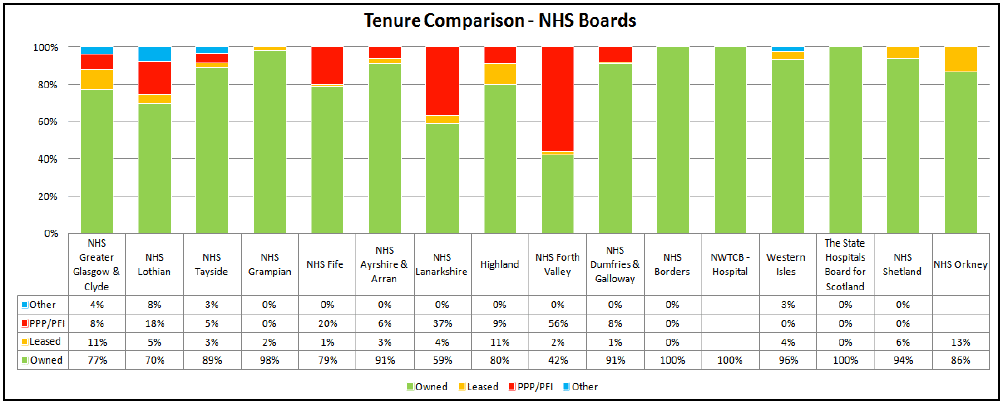
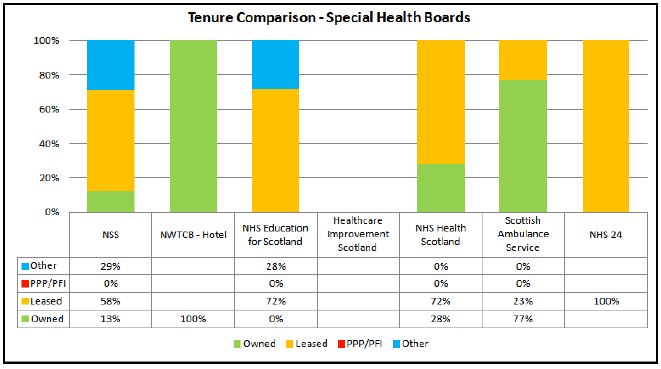
Physical condition
Analysis of the information contained within each NHS Board's Property and Asset Management Strategy (PAMS) shows that approximately 67% of the NHSScotland estate is in good physical condition (category A or B) but, as shown in the three charts that follow, this can vary significantly across the NHS Boards.
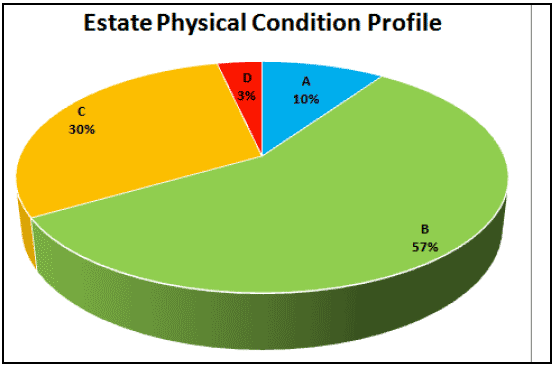
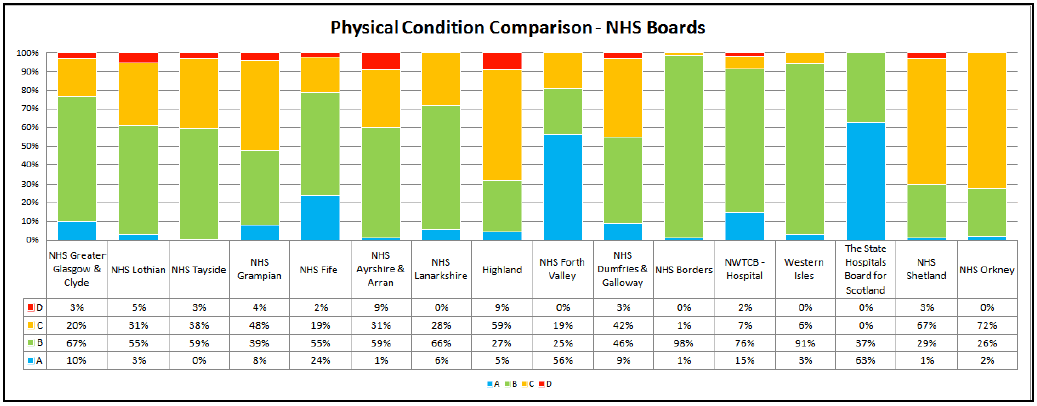
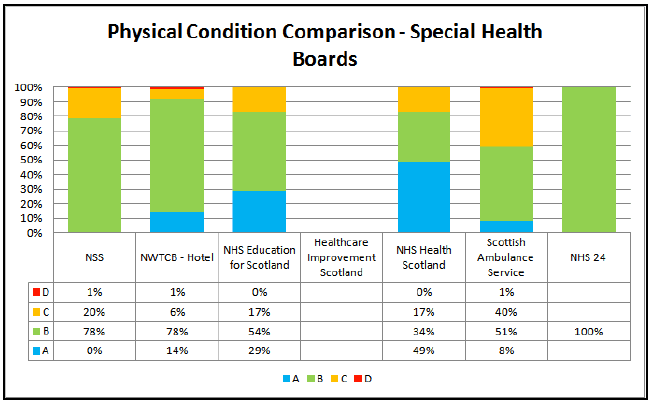
Further to the above Board level analysis, it is now possible, through the Estate Asset Management System (EAMS), to report on estate KPI's such as physical condition and backlog maintenance at hospital level. Analysis of this information enables links to be made between property improvement needs and the strategic plans for improvement included within the appropriate NHS Board's PAMS.
The following table lists the 10 NHSScotland hospitals with the largest percentage of accommodation categorised as either C or D for the facet of Physical Condition. The total area of 191,013 sq.m. represents only 13% of NHSScotland's overall estate.
Prioritisation of investment on these properties may, therefore, resolve local problems with the condition of their estate but will form only a small portion of NHSScotland's estate in need of improvement in physical condition (note, a similar table that considers hospitals with the largest 'total area' in C or D is included in Section 5.1.4 of the main body of this report).
| 10 Hospitals with largest percentage of area categorised as either C or D for the facet of Physical Condition |
||||
|---|---|---|---|---|
| NHS Board |
Property |
KPI: Percentage in C or D |
Floor Area (sq.m) in C or D |
Strategic Plan (identified from the Board's PAMS) |
| NHS Greater Glasgow & Clyde |
Lightburn Hospital |
100% |
5,815 |
Part of general backlog maintenance programme |
| NHS Greater Glasgow & Clyde |
Mansion House Unit |
100% |
11,464 |
Part of estate rationalisation plans |
| NHS Lothian |
Royal Victoria Hospital |
100% |
11,143 |
Replacement building now complete hence planned disposal |
| NHS Shetland |
Gilbert Bain Hospital |
98% |
8,607 |
NHS Shetland are working on a medium to long term plan for the Acute hospital estate |
| NHS Lothian |
Corstophine Hospital |
95% |
3,346 |
Future plans being developed |
| NHS Lothian |
Royal Edinburgh Hospital |
90% |
45,262 |
Phased redevelopment of site from 2014 onwards |
| NHS Fife |
Netherlea Hospital |
84% |
886 |
Planned disposal 2014/15 |
| NHS Grampian |
Aberdeen Maternity Hospital |
83% |
12,100 |
Future plans to be confirmed |
| NHS Greater Glasgow & Clyde |
Gartnavel General Hospital |
80% |
52,200 |
Part of general backlog maintenance programme |
| NHS Lanarkshire |
Monklands Hospital |
77% |
40,190 |
Backlog investment programme in place |
| TOTAL AREA: | 191,013 |
|||
Backlog maintenance costs
Backlog maintenance costs arise from maintenance that has built up over a number of years and is now giving rise to poor condition and performance. These backlog maintenance costs have been identified as those required to bring the estate back to Condition Ranking B (satisfactory). It is an on-going challenge for the NHS to balance investment between that which is focussed on service improvement and development, and that which is necessary to ensure existing properties do not cause harm or undue disruption to service delivery.
An analysis of the distribution of backlog across NHS Boards is shown in the chart below. It identifies a backlog maintenance cost of £858m, which is a £152m reduction since 2011.
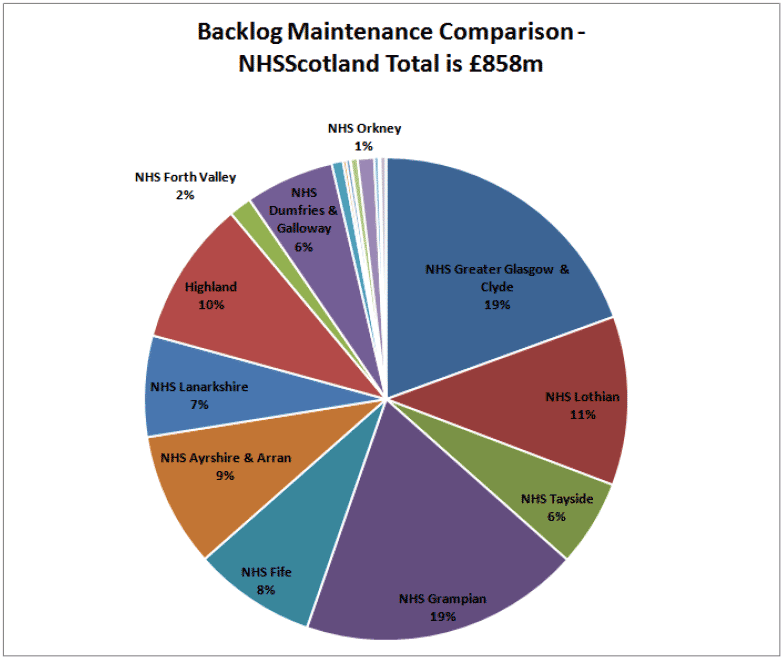
Note: the above chart includes all 22 NHS Boards and Special NHS Boards but those whose backlog is below 1% have not been separately identified for clarity of presentation reasons only.
By the very nature of a mixed use and mixed aged estate, backlog maintenance will always be present in such a large and diverse estate. The emphasis should, therefore, always be on ensuring that the level of backlog maintenance does not unduly increase the risk of building or engineering service failure to an extent that it could have a detrimental impact on each NHS Board's ability to function effectively, efficiently and safely.
NHSScotland managers are focussed on mitigation strategies for the significant backlog maintenance requirement to ensure that high and significant risk backlog is prioritised, based on the risk it poses, for investment within the finite resources made available to them.
The two key strategies for reducing backlog maintenance are either to invest directly in the rectification of backlog or to rationalise the estate to remove those properties with high levels of backlog maintenance. For the current stock of modern buildings future backlog can be avoided by ensuring the right levels of expenditure on both operational and cyclical lifecycle maintenance.
The following chart identifies the profile of low, moderate, significant and high risk backlog for each NHS Board.
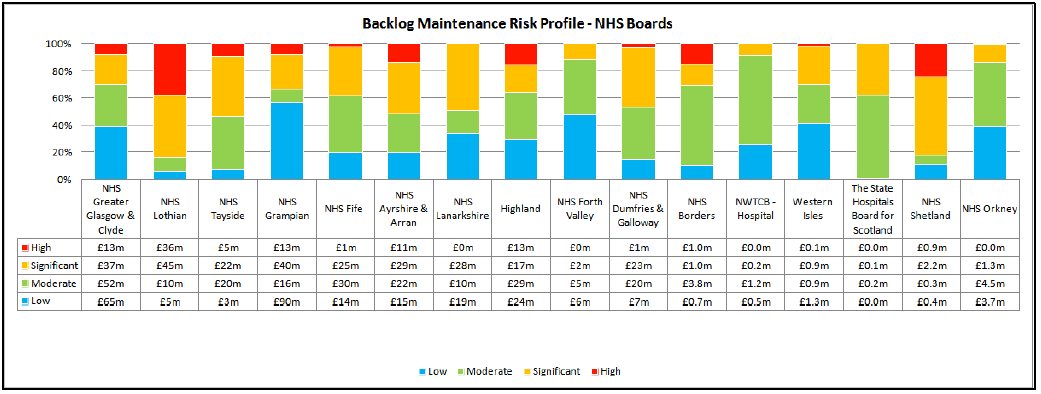
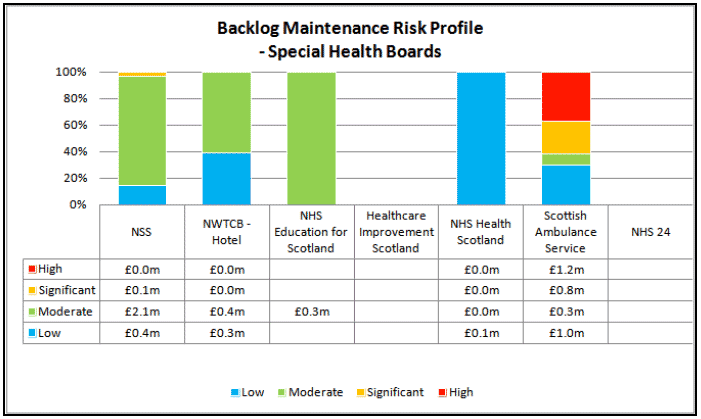
The earlier pie chart expressed the total amount of Backlog Maintenance Cost across the NHSScotland estate, whereas the following chart shows backlog maintenance expenditure requirement per unit of total building floor area for each NHS Board. The table then lists the 10 hospitals across NHSScotland with the highest cost per sq.m. for backlog maintenance.
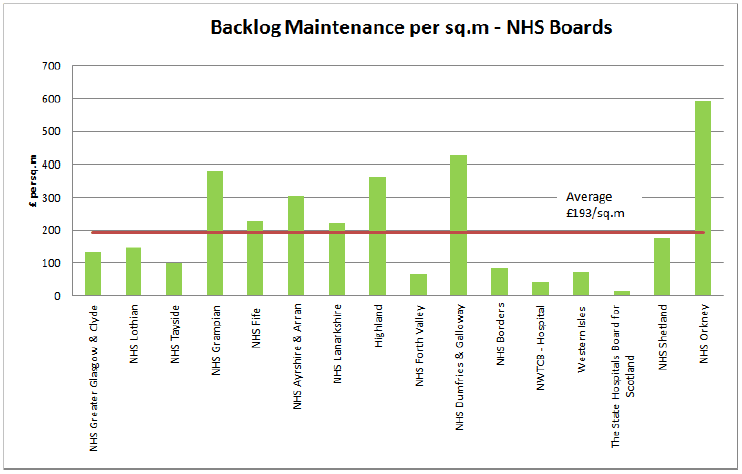
| 10 Hospitals with the highest Backlog Maintenance - Cost per sq.m |
||||
|---|---|---|---|---|
| NHS Board |
Property |
Backlog Cost per sq.m |
Total Backlog Cost |
Strategic Plan (identified from the Board's PAMS) |
| NHS Orkney |
Balfour Hospital |
£992 |
£7.0m |
Planned replacement of hospital in 2017/18 |
| NHS Highland |
Mackinnon Hospital |
£949 |
£2.4m |
Scheduled replacement in 2016/17, subject to public consultation |
| NHS Dumfries & Galloway |
Dumfries & Galloway Hospital |
£812 |
£39.0m |
Planned hospital replacement and estate rationalisation between 2015/16 - 2018/19 |
| NHS Lothian |
Corstophine Hospital |
£789 |
£2.8m |
Future plans being developed |
| NHS Dumfries & Galloway |
Cameron House |
£783 |
£0.2m |
Part of longer term rationalisation programme |
| NHS Lanarkshire |
Monklands Hospital |
£744 |
£38.6m |
Backlog investment programme in place |
| NHS Dumfries & Galloway |
Thornhill Hospital |
£691 |
£0.5m |
No direct plans identified in PAMS |
| NHS Highland |
Belford Hospital |
£645 |
£4.4m |
Scheduled replacement in 2017/18, subject to public consultation |
| NHS Lothian |
Royal Victoria Hospital |
£607 |
£7.2m |
Replacement building now complete, hence planned disposal |
| NHS Dumfries & Galloway |
Kirkcudbright Hospital |
£584 |
£0.4m |
No direct plans identified in PAMS |
| TOTAL BACKLOG: |
£102.5m |
|||
The total cost associated with these properties of £102.5m accounts for only 12% of the overall backlog maintenance cost for NHSScotland (47% of this £102.5m is attributable to significant and high risk backlog). Prioritisation of investment on these properties will, therefore, resolve local problems with backlog maintenance but will form only a small portion of the targeted reduction in backlog maintenance across NHSScotland.
It should also be recognised that around 21% of the current backlog maintenance expenditure requirement is in buildings which are classified as "non-clinical" and will have little impact on the patient's healthcare experience. An analysis of this by NHS Board is shown in the chart below.
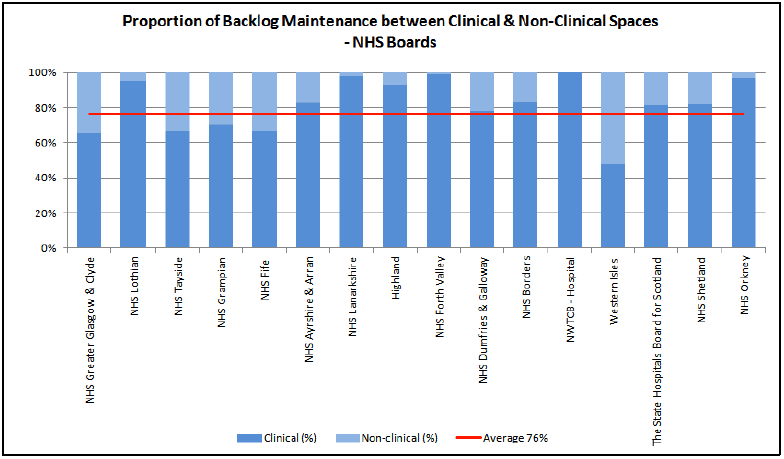
Note: not all NHS Boards have provided a split between Clinical and Non-clinical therefore the real 'Average Split' is likely to be even lower.
Approximately 35% of the total backlog maintenance expenditure identified is high or significant risk clinical space. This includes some property identified for disposal.
NHS Boards are already targeting high and significant risk clinical backlog maintenance through planned maintenance and re-provision plans outlined in their PAMS. Overall, Scottish Government budgeting levels should be sufficient to reduce existing high and significant clinical backlog maintenance levels for retained property to manageable levels over the next five years.
For lower risk backlog maintenance and non clinical space, Scottish Government will work with NHS Boards to develop detailed long term plans for rationalisation and disposal of surplus, unsuitable, poor quality properties, and life cycle planned maintenance plans for retained property. These will be updated annually as part of the PAMS update and reviewed more formally through the LDP process.
Space utilisation
Accommodation space has a direct relationship with cost. The aim, therefore, is to hold only that space which is needed to support the delivery and support of effective and efficient service delivery. Analysis of the information contained within each NHS Board's Property and Asset Management Strategy shows that approximately 77% of the NHSScotland estate is fully utilised but, as shown in the charts that follow, this can vary significantly across the NHS Boards.
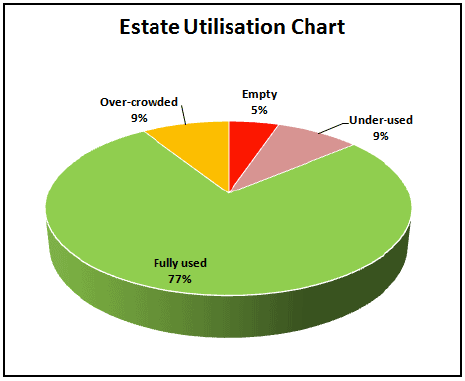
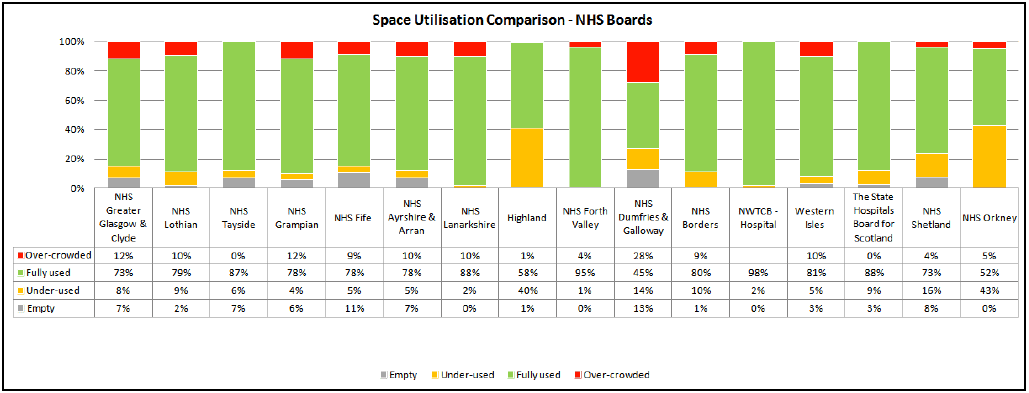
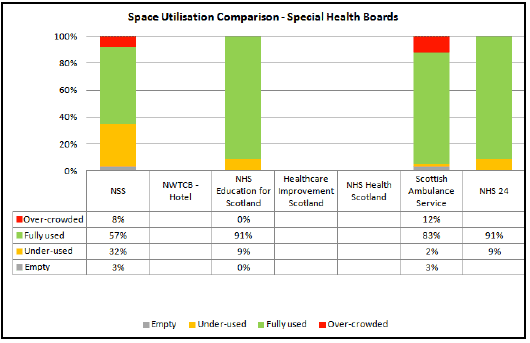
The under utilisation of accommodation across NHS Highland and NHS Orkney reflects the challenges faced from such a geographically diverse area and the need to maintain and provide critical healthcare facilities in locations with relatively low population masses.
Functional suitability
The estate also plays an important role in supporting the effective delivery of services. Poor functional suitability often results in inefficient working practices, increased staffing levels and poor clinical outcomes. Approximately 75% of the NHSScotland estate is functionally suitable but, as shown in the charts that follow, this can vary significantly across NHS Boards.
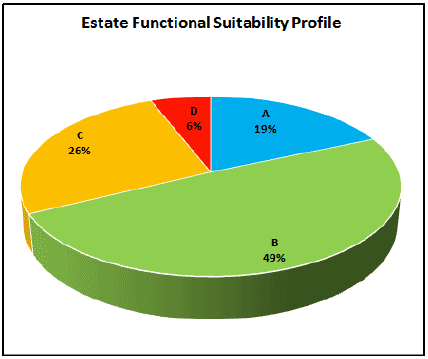
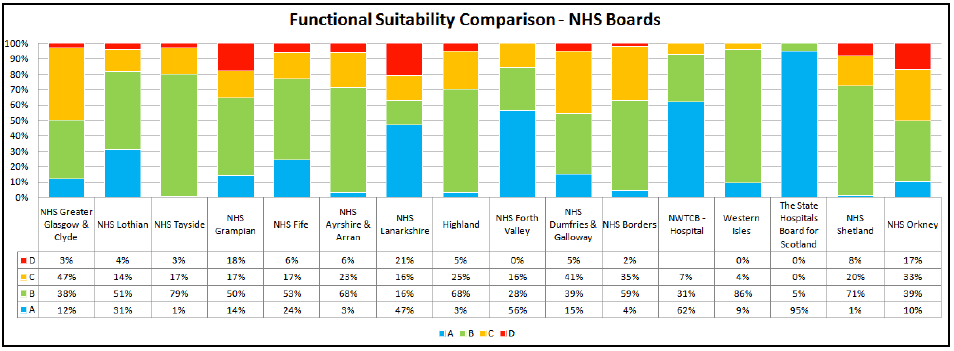
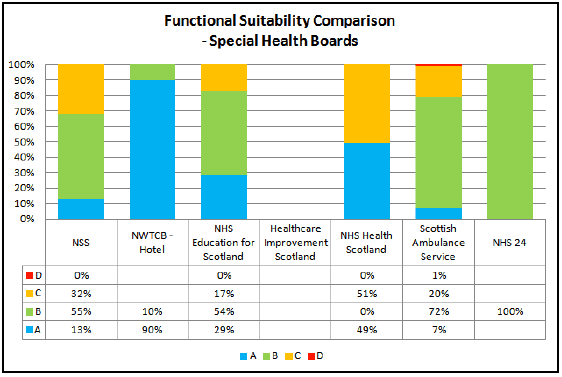
Patient Satisfaction Survey Results relevant to Premises
Better Together is Scotland's patient experience programme, using the public's experiences of NHSScotland to improve health services. One of the key elements it is currently focussed on is the Inpatients Patient Experience Survey 2012. This asked a range of questions about people's experiences of staying overnight in a Scottish hospital and included a particular question that was relevant to the condition and performance of the hospital estate, namely "Q.13 Overall, how would you rate the hospital environment?" The following chart shows the results of the response to this question for each NHS Board:
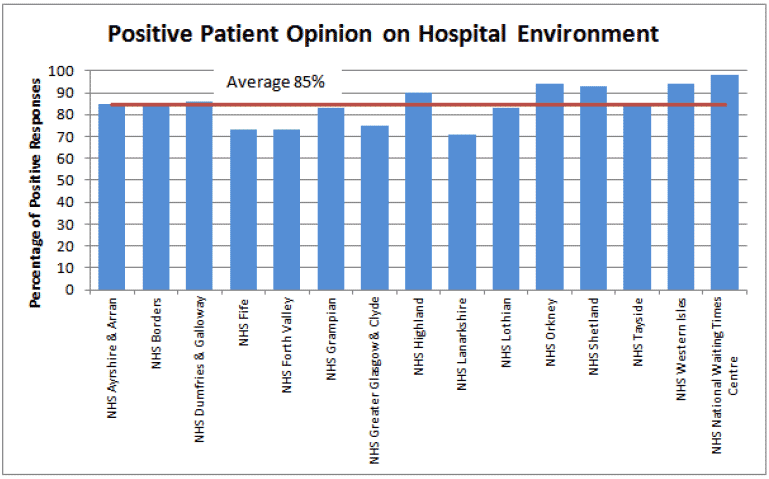
Note: No data is available for the State Hospital Board
The results are generally positive across all NHS Boards, however, it needs to be recognised that these results are based on only one question and, therefore, should not be taken as indicating overall patient satisfaction in NHSScotland premises.
Performance Improvement of Property Assets
The following chart provides a comparative overview of performance improvement in property assets between 2012 and 2013:
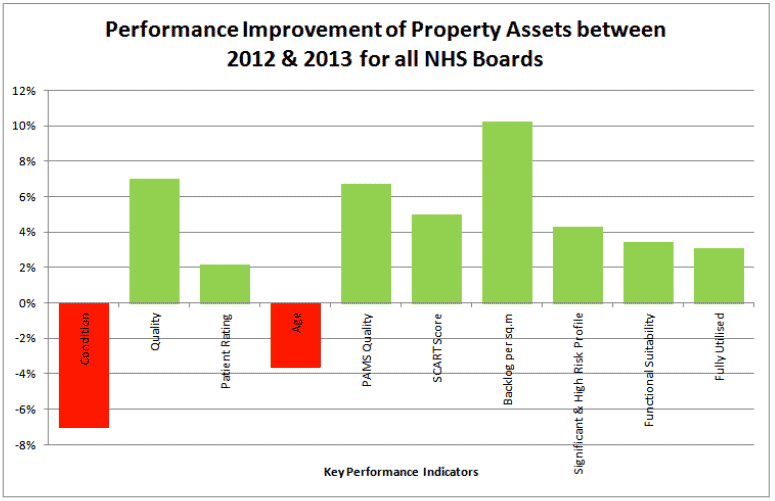
Note: green bars above the horizontal indicate a positive improvement whereas a red bar below the horizontal indicates a performance reduction
The above chart highlights performance improvement in several key indicators; such as quality of properties, patient rating, quality of PAMS, backlog maintenance, functional suitability, and space utilisation. The main focus for NHS Boards over this year has been estate rationalisation and reduction in backlog maintenance and these positive results reflect the good progress made on these initiatives. 2012-13 has also seen a significant re-appraisal of the condition and performance of property assets, including verification of existing data. This has had an impact on the above results and can explain some of the further variation in performance results between 2012 and 2013.
Contact
Email: Gillian McCallum
There is a problem
Thanks for your feedback